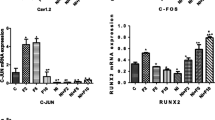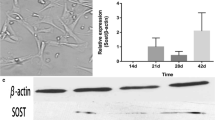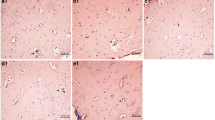Abstract
Calcium homeostasis of osteoblasts (OBs) has an important role in the physiology and pathology of bone tissue. In order to study the mechanisms of intracellular calcium homeostasis, MC3T3-E1 cells and Sprague-Dawley rats were treated with different concentrations of fluoride. Then, we examined intracellular-free calcium ion ([Ca2+]i) in MC3T3-E1 cells as well as mRNA and protein levels of Cav1.2, the main subunit of L-type voltage-dependent calcium channels (VDCCs), Na+/Ca2+ exchange carriers (NCS), and plasma membrane Ca2+-ATPase (PMCA), inositol 1,4,5-trisphosphate receptor (IP3R) channels, sarco/endoplasmic reticulum calcium ATPase 2b (SERCA2b)/ATP2A2 in vitro, and rat bone tissues in vivo. Our results showed that [Ca2+]i of fluoride-treated OBs increased in a concentration-dependent manner with an increase in the concentration of fluoride. We also found that the low dose of fluoride led to high expression levels of Cav1.2, NCS-1, and PMCA and low expression levels of IP3R and SERCA2b/ATP2A2, while the high dose of fluoride induced an increase in SERCA2b/ATP2A2 levels and decrease in Cav1.2, PMCA, NCS-1, and IP3R levels. These results demonstrate that calcium channels and calcium pumps of plasma and endoplasmic reticulum (ER) membranes keep intracellular calcium homeostasis by regulating Cav1.2, NCS-1, PMCA, IP3R, and SERCA2b/ATP2A2 expression.









Similar content being viewed by others
References
Talmage DW, Talmage RV (2007) Calcium homeostasis: how bone solubility relates to all aspects of bone physiology. J Musculoskelet Neuronal Interact 7:108–112
Talmage RV, Mobley HT (2009) The concentration of free calcium in plasma is set by the extracellular action of non-collagenous proteins and hydroxyapatite. Gen Comp Endocrinol 162:245–250
Bronner F (2001) Extracellular and intracellular regulation of calcium homeostasis. Sci World J 1:919–925
Pan CC, Cheng HH, Huang CJ, et al (2006) The antidepressant mirtazapine-induced cytosolic Ca2+ elevation and cytotoxicity in human osteosarcoma cells. Chin J Phys 49:290–297
Blair HC, Schlesinger PH, Huang CL, et al (2007) Calcium signalling and calcium transport in bone disease. Subcell Biochem 45:539–562
Lieben L, Carmeliet G (2012) The involvement of TRP channels in bone homeostasis. Front Endocrinol (Lausanne) 3:99
Duan XQ, Zhao ZT, Zhang XY, et al (2014) Fluoride affects calcium homeostasis and osteogenic transcription factor expressions through L-type calcium channels in osteoblast cell line. Biol Trace Elem Res 162:219–226
Nakano Y, Addison WN, Kaartinen MT (2007) ATP-mediated mineralization of MC3T3-E1 osteoblast cultures. Bone 41:549–561
Stains JP, Weber JA, Gay CV (2002) Expression of Na(+)/Ca(2+) exchanger isoforms (NCX1 and NCX3) and plasma membrane Ca(2+) ATPase during osteoblast differentiation. J Cell Biochem 84:625–635
Stains JP, Gay CV (2001) Inhibition of Na/Ca2 exchange with KB-R7943 or bepridil diminishes mineral deposition by osteoblasts. J Bone Miner Res 16:1434–1443
Kuroda Y, Hisatsune C, Nakamura T, et al (2008) Osteoblasts induce Ca2+ oscillation-independent NFATc1 activation during osteoclastogenesis. Proc Natl Acad Sci U S A 105:8643–8648
Wilcox RA, Forsythe ID, McCann TJ (2005) Microinjection of myo-inositol (1,4,5)- trisphosphate and other calcium-mobilizing agents into intact adherent cells. Methods Mol Biol 312:213–228
Adebanjo OA, Biswas G, Moonga BS, et al (2000) Novel biochemical and functional insights into nuclear Ca(2+) transport through IP(3)Rs and RyRs in osteoblasts. Am J Physiol Ren Physiol 278:F784–F791
Kirkwood KL, Dziak R, Bradford PG (1996) Inositol trisphosphate receptor gene expression and hormonal regulation in osteoblast-like cell lines and primary osteoblastic cell cultures. J Bone Miner Res 11:1889–1896
Bredoux R, Corvazier E, Dally S, et al (2006) Human platelet Ca2+-ATPases: new markers of cell differentiation as illustrated in idiopathic scoliosis. Platelets 17:421–433
Chen T, Ghosh P, Misquitta CM, et al (2007) Characterization of SERCA2b Ca2+-Mg2+ ATPase mRNA decay by nuclear proteins. Cell Calcium 41:581–592
Caspersen C, Pedersen PS, Treiman M (2000) The sarco/endoplasmic reticulum calcium-ATPase 2b is an endoplasmic reticulum stress-inducible protein. J Biol Chem 275:22363–22372
Ahn W, Lee MG, Kim KH, et al (2003) Multiple effects of SERCA2b mutations associated with Darier’s disease. J Biol Chem 278:20795–20801
Wei H, Li Z, Wang X, et al (2015) MicroRNA-151-3p regulates slow muscle gene expression by targeting ATP2a2 in skeletal muscle cells. J Cell Physiol J Cell Physiol 230:1003–1012
Ren G, Ferreri M, Wang Z, et al (2011) Sodium fluoride affects proliferation and apoptosis through insulin-like growth factor 1 receptor in primary cultured mouse osteoblasts. Biol Trace Elem Res 144:914–923
Xu H, Zhao ZT, Jing L, et al (2009) Study on endoplasmic reticulum stress in bone tissue of fluorosis rats. Chin J Endemiol 28:36–40
Hu Q, Fu H, Ren T, et al (2008) Maternal low-level lead exposure reduces the expression of PSA-NCAM and the activity of sialyltransferase in the hippocampi of neonatal rat pups. Neurotoxicology 29:675–681
Duan XQ, Xu H, Wang Y, et al (2014) Expression of core-binding factor α1 and osteocalcin in fluoride-treated fibroblasts and osteoblasts. J Trace Elem Med Biol 28:278–283
Jing L, Zhao YZ, Qi L, et al (2005) Dose-effect relationship between fluoride and proliferation activity of fibroblast. Chin J Endemiol 24:517–519
Fujita T, Palmieri GM (2000) Calcium paradox disease: calcium deficiency prompting secondary hyperparathyroidism and cellular calcium overload. J Bone Miner Metab 18:109–125
Mauro T (2014) Endoplasmic reticulum calcium, stress, and cell-to-cell adhesion. J Investig Dermatol 134:1800–1801
Acknowledgments
This work was supported by a grant for skeletal fluorosis research from the National Natural Science Foundation of China (81172608).
Conflict of Interest
The authors declare that they have no competing interests.
Author information
Authors and Affiliations
Corresponding author
Rights and permissions
About this article
Cite this article
Duan, Xq., Li, Yh., Zhang, Xy. et al. Mechanisms of Intracellular Calcium Homeostasis in MC3T3-E1 Cells and Bone Tissues of Sprague-Dawley Rats Exposed to Fluoride. Biol Trace Elem Res 170, 331–339 (2016). https://doi.org/10.1007/s12011-015-0465-6
Received:
Accepted:
Published:
Issue Date:
DOI: https://doi.org/10.1007/s12011-015-0465-6




